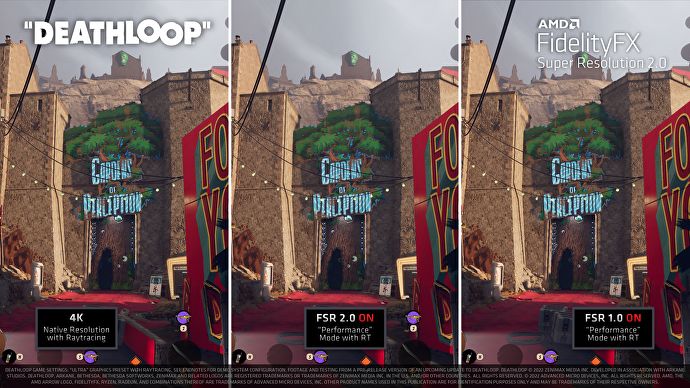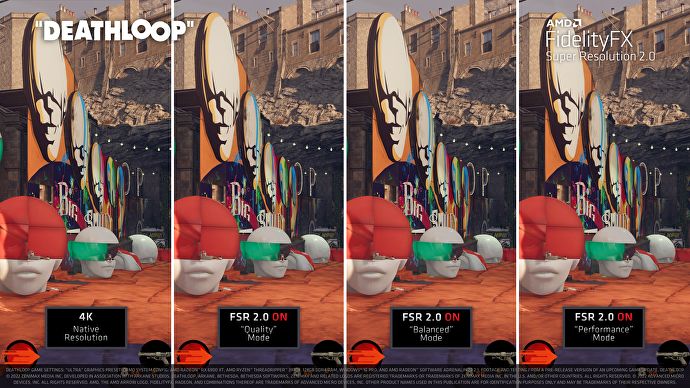AMD FSR 2.0 is a more demanding, higher-quality upscaling upgrade

AMD have revealed more about FSR 2.0, the major overhaul of its FidelityFX Super Resolution upscaling tech, after a detail-light announcement last week. FSR 2.0 will represent a switch from simple spatial upscaling to more closely match the advanced temporal upscaling techniques of its rival, Nvidia DLSS – and while it won’t use DLSS-style machine learning, AMD say the trick to FSR 2.0’s improved performance is down to some good-old-fashioned human brainpower.
I appreciate that’s already a lot of dull techy words, so here’s the basics. Both FSR and DLSS aim to improve frames-per-second in games by rendering them below your monitor’s native resolution, then upscaling them to make up the difference in sharpness. Currently, FSR uses spatial upscaling, meaning it only applies its upscaling algorithm to one frame at a time. Temporal upscalers, like DLSS, can compare multiple frames at once, to reconstruct a more finely-detailed image that both more closely resembles native res and can better handle motion. DLSS specifically uses the machine learning capabilities of GeForce RTX graphics cards to process all that data in (more or less) real time.
FSR 2.0 will use temporal upscaling too, although with purely human-designed algorithms to crunch data from multiple frames, rather than machine learning. The result, on paper, is vastly improved image quality compared to the spatial FSR 1.0, without need of dedicated machine learning hardware like that of the RTX series. AMD revealed comparison images for Deathloop, one of the first games that will support FSR 2.0 when it launches, showing the sharpness difference between the old and new upscalers:

in a community blog post, AMD software product marketing specialist Alex Blake-Davies explained why machine learning was deemed unnecessary: “Broadly speaking, machine learning (ML) is an incredibly useful set of tools and techniques that can aid and accelerate this process. However, the results that ML achieves can sometimes not be the most optimal, lacking the spark of human imagination that can often lead to breakthroughs for complex problems. ”
“Often, ML-based real-time temporal upscalers use the model learned solely to decide how to combine previous history samples to generate the upscaled image: there is typically no actual generation of new features from recognizing shapes or objects in the scene. AMD engineers leveraged their world-class expertise to research, develop, and optimize a set of advanced hand-coded algorithms that map such relationships from the source and its historical data to upscaled resolutions.”
I’m not sure that machine learning lacks a human touch to the extent that Blake-Davies presents it – tech like DLSS is ultimately designed, built and updated by people too. But the chance to move away from needing dedicated GPU hardware is worth pursuing, especially if FSR 2.0 really can get close to DLSS on quality without significantly lowering its performance gains.

However, the post also says FSR 2.0 will be more demanding on graphics cards than FSR 1.0. It will still be usable on both AMD and Nvidia GPUs (handy if you’ve already invested in one of the best graphics cards from the GeForce lineup), but unlike with version 1.0, AMD will recommend certain models for certain resolutions. When upscaling to 4K, for instance, at least a Radeon RX 5700 or GeForce RTX 2060 are suggested, while upscaling to 1440p comes with recommendations for a Radeon RX 5600, a GTX 1080, or better.
In fairness, these are the kinds of cards you’d want to play at those respective resolutions anyway. More aged models like the Radeon RX 470 or GeForce GTX 970 aren’t listed among the recommendations, though they might still work – just not as well as newer, more powerful cards.
FSR 2.0 is due to launch in Q2 2022 (April to the end of June). So far only Deathloop and Forspoken are confirmed to support it, and the latter isn’t out until October itself, though AMD are working directly with other developers to get FSR 2.0 up and running on “as many games as possible”.
Reference-www.rockpapershotgun.com